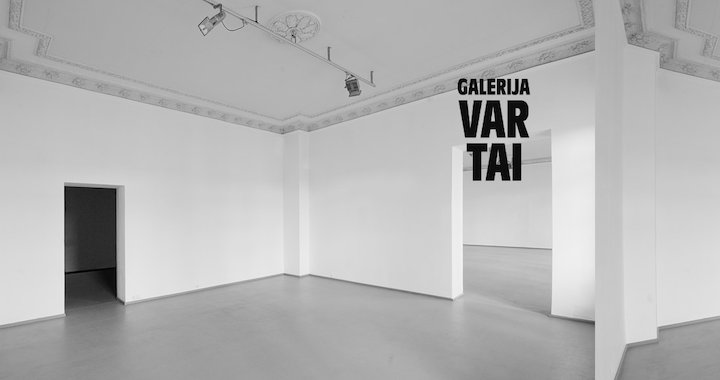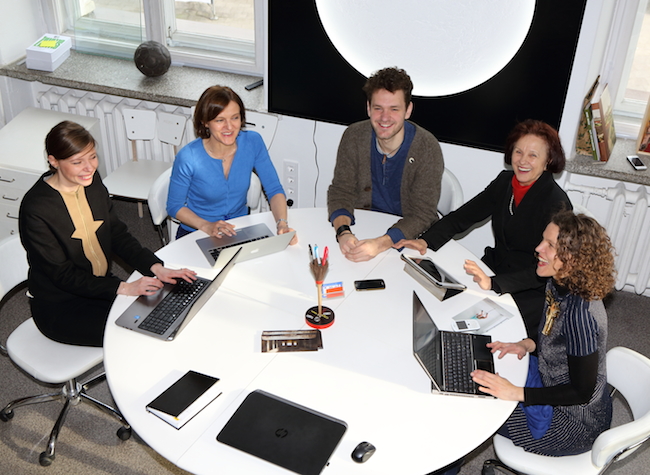
Vilnius’ Vartai Gallery Turns 25
22/02/2016
The gallery VARTAI in Vilnius is widely known as one of the most powerful institutions of contemporary art in the Baltics ever since the region's renewed independence. Having first opened its doors in February 1991, this enduring establishment celebrates its 25th anniversary this year. Before heads to the celebratory event, the likes of which are usually marked with the opening of a truly notable exhibition (which holds true for this case as well – VARTAI's anniversary exhibition, Žilvitis [Eng: Willow], will feature practically all of the artists whose internationally successful careers got their start at the gallery), we decided to gather up a brief overview of the gallery's history.

VARTAI team, 2016. Photo: Gintaras Janavičius
We were aided in this endeavor by Laura Rutkutė, the gallery's creative director (and daughter of the gallery's founder, Nida Rutkienė), who today runs the gallery together with her sister, Agnė Rutkutė-Savarauskienė.
More Than 600 Exhibitions In 25 Years
After a 50-year-long lethargic sleep in the isolated ward that was the Soviet Union, Nida Rutkienė – together with a team of artists, architects and art historians – opened 400 m2 of gallery space with five exhibition rooms that were regularly changed every three weeks for the first ten of years of the gallery's operation. Today, exhibitions at VARTAI are changed every six or eight weeks, with one or two weeks of hiatus in between them; usually two or three exhibitions are going on at the same time, which sums up to more than 600 exhibitions having been held at the gallery.
João Paulo Feliciano exhibition in 2009
The Twists and Turns of VARTAI Over Three Decades
The 1st Decade
In its first decade, VARTAI played a major role as a hub for different arts and artists, authors and book presentations, and even as a meeting place for foreign Ambassadors and their families who were establishing their country representatives in the re-established Lithuanian Republic. It was one of the most dynamic and active spots in Vilnius at that time – a place where artist and other activists gathered almost daily to exchange ideas, experiences, discuss issues, and develop future plans.

The exhibition of the works of Prince Charles at Galerija VARTAI, in 1998. In the photo: The British Ambassador at that time Christopher Robbins is presenting a watercolour of Prince Charles to the President of the Republic of Lithuania Valdas Adamkus and his wife Alma Adamkienė. Photo: Džoja Gunda Barysaitė
The country was in lack of a place like that for long decades while under the Soviet Union, so there was a big gap to fill. VARTAI changed its exhibitions every three weeks, organized concerts every week, and gave free use of the space and the grand piano (an important member of the gallery since its very beginnings) to musicians and students for rehearsals.
The 2nd Decade
Beginning with its second decade, VARTAI started to progressively become active abroad – participating in art fairs and organizing exhibitions outside of Lithuania.
The 3rd Decade
After another five years had passed, the gallery started to hold more exhibitions that were exclusively focused on contemporary art. Although the change wasn't radical, but rather organic and done step by step, it was a truly major change.
From Vilnius to the Top of the World
Over the years, VARTAI gallery has also become a stepping stone to an international career in art for more than just one Lithuanian artist. Among these are Andrius Zakarauskas and Ugnius Gelguda, who after working with VARTAI in 2006, continued their trajectories to such large-caliber European art fairs as Berliner Kunstsalon, Art Cologne, Arco, Art Brussels, Artissima, etc.; their works have also entered the collections of notable institutions and private collectors.

Žilvinas Kempinas. Tube, 2008. Venice biennale 2009
Also worth noting is the fact that the New York-based Lithuanian artist Žilvinas Kempinas (well-known for his kinetic installations) may have started his career in New York, but he certainly gained a powerful push up the ladder of recognition after participating in the 2009 Venice Biennale. There, his large-format installation “Tube” – of which many a festival-goer surely still has vivid memories – was commissioned by Laura Rutkutė and partially financially supported by VARTAI.
International Artists, a Local Market
Although over the last 10 to 15 years VARTAI has been actively working on an international scale by participating in Europe's largest art fairs (from Viennafair [now the Vienna Contemporary] to Art Cologne and ARCOmadrid) and working on cooperative projects with other galleries, institutions and museums, the gallery mostly focuses on contemporary art education on a local level, as well as on supporting the local art market. That means that the gallery places an equal amount of emphasis on both Lithuanian and foreign artists, and both on new artists and already established ones. Since 2009, Vartai has exhibited such artists as Knut Åsdam (Norway), Ignasi Aballi (Spain), Rafał Bujnowski (Poland), Hans Op de Beeck (Belgium), Tatjana Doll (Germany), João Paulo Feliciano (Portugal), Vadim Fishkin (Russia), Jesper Just (Denmark), Žilvinas Kempinas (Lithuania/USA), Atelier Van Lieshout (the Netherlands), Deimantas Narkevičius (Lithuania), Alyson Shotz (USA), S&P Stanikas (Lithuania), Franz West (Austria), and Erwin Wurm (Austria).

Erwin Wurm. Fat Car, 2002. Exhibition Mindwalk at Galerija VARTAI, 2013. Photo: A. Valiaugos
Specifically, the gallery's exhibitions of works by Hans Ob de Beeck, Jasper Just, Žilvinas Kempinas, and Erwin Wurm were the ones to have attracted the most visitors in the last ten years.
A Word from Laura Rutkutė, Creative Director of Gallery VARTAI
What has been the key to the VARTAI gallery's success? Dedication and a continuous everyday work routine. The successes as well as the failures – they happen and they pass, but the daily routine stays uninfluenced.
What have been the major milestones or turning points experienced by the gallery? Its development was very sequential and influenced by different circumstances, but mainly, the persons involved and the breaking-open of the country's borders.
What are some of the mistakes that the gallery has learned from? We have learned from many mistakes. From some we did not, but the lesson we have learned is: Believe in what you do, and do not expect to receive appreciation.
What does the VARTAI gallery see in its future? Any visions or plans? VARTAI seeks to expand by opening a branch elsewhere in Europe, as well as hopes to gain more independence from external factors.

Deimantas Narkevičius. The Role of Lifetime. 2003. Video. Exhibition Sounds Like the XX Century at Vartai in 2014. Photo: Arnas Anskaitis
An Overview of VARTAI Gallery's 2016 Schedule
- To celebrate its 25th birthday, VARTAI gallery has in its exhibition “Žilvitis” (February 19 – April 2) assembled the artists with whom it has not only collaborated the most over one decade, but also those who have gained international recognition. Included in this lucky group are Žilvinas Kempinas, Deimantas Narkevičius, Svajonė and Paulius Stanikas, Julijonas Urbonas, Andrius Zakarauskas, Jurga Barilaitė, Laura Garbštienė, Ugnius Gelguda, Robertas Narkus, Linas Jusionis, Ignas Krunglevičius, Rūtenė Merkliopaitė, and VytautasViržbickas. Enhancing the exhibition are installations that were specially made for the event by the art critic Danutė Gambickaitė and the artist Arnas Anskaitis. Read more…
- Planned are shows by the Lithuanian artist Andrius Zakarauskas, and the Portugese artist Pedro Cabrita Reis, as well as exhibition by Heimo Zobernig (Austria) and Julia Haller (Germany), curated by Amer Abbas.
